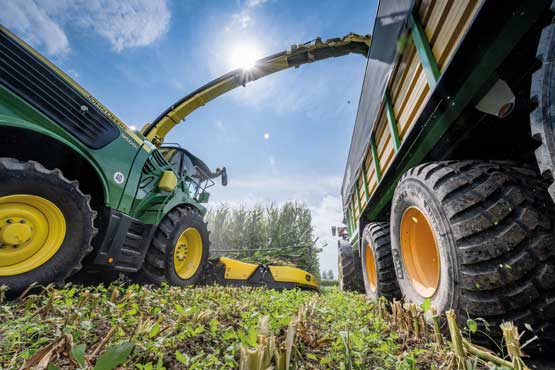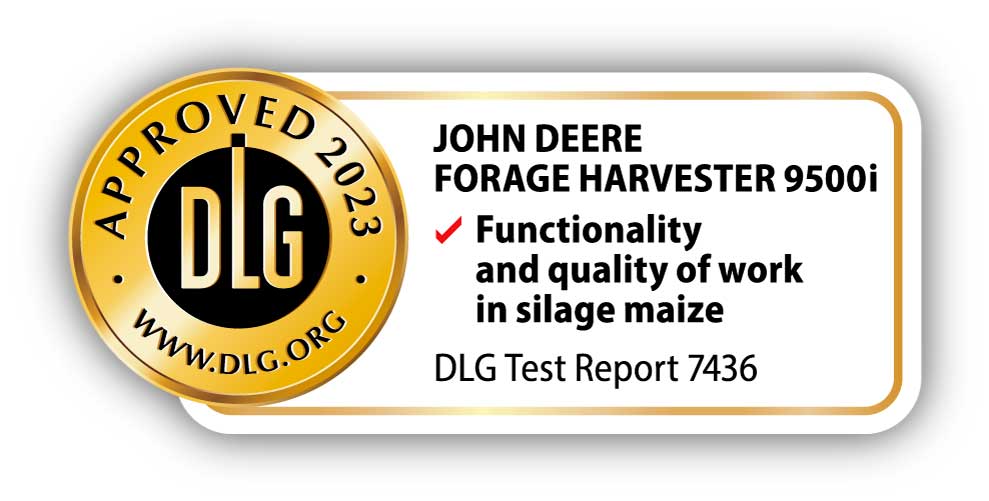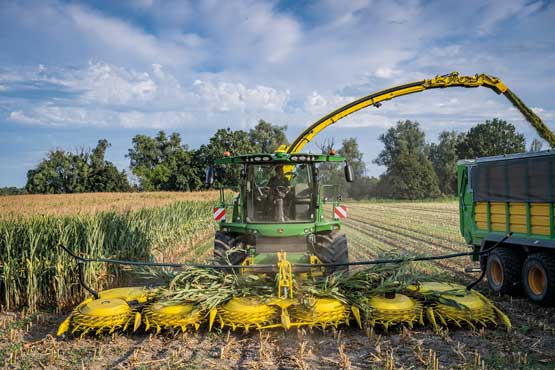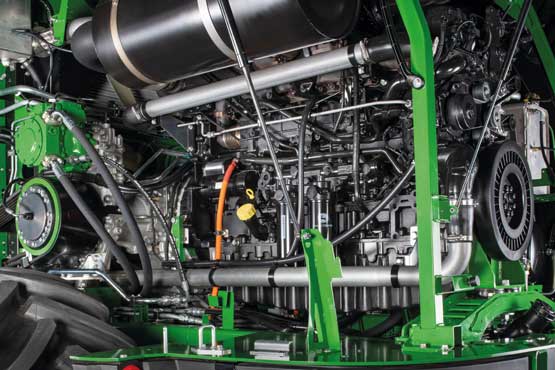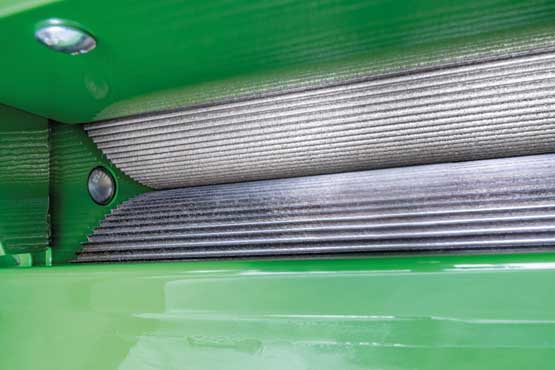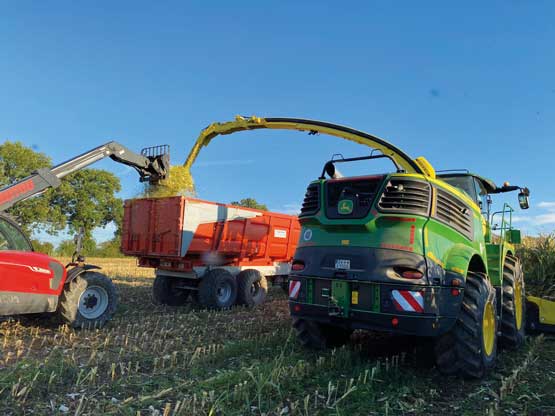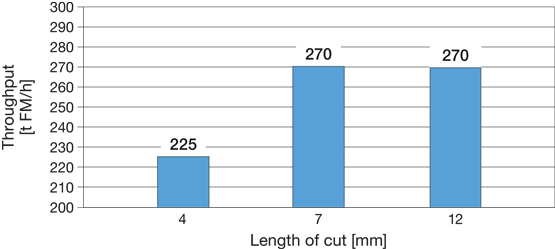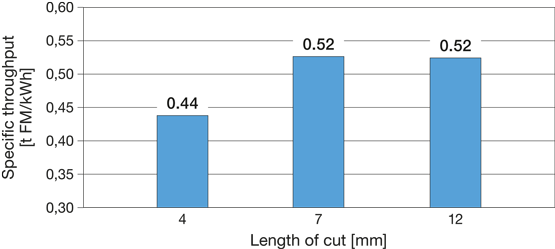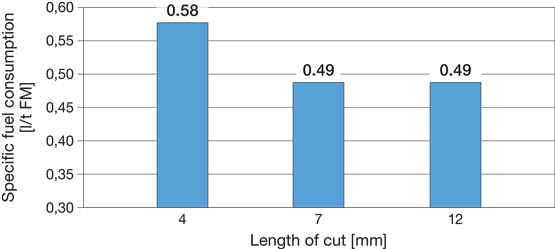Forage Harvester 9500 i
DLG-APPROVED: "Functionality and quality of work in silage maize"
The approval
A test mark „DLG-APPROVED for individual criteria“ is awarded for agricultural products which have successfully fulfilled a scope-reduced usability testing conducted by DLG according to independent and recognised evaluation criteria. The test is intended to highlight particular innovations and key criteria of the test object. The test may contain criteria from the DLG test scope for overall tests, or focus on other value-determining characteristics and properties of the test subject. The minimum requirements, test conditions and procedures as well as the evaluation bases of the test results will be specified in consultation with an expert group of DLG. They correspond to the recognised rules of technology, as well as scientific and agricultural knowledge and requirements. The successful testing is concluded with the publication of a test report, as well as the awarding of the test mark which is valid for five years from the date of awarding.
The John Deere 9500 i forage harvester was subjected to the DLG partial test “Functionality and quality of work in silage maize”. This test involved a number of field tests during which the work rates and corresponding fuel consumption rates were measured. These measurements were used to compute throughputs [t/FM/h] and specific fuel consumption rates [l/t FM] of the machine. The tests also included measurements of the technical quality of chop. All test parameters were measured with the machined set to three different chop length settings (4 mm, 7 mm, 12 mm). For this purpose, samples were taken from the crop flow of the forager in each test variant and subjected to a particle size distribution analysis and the CSPS index (Corn Silage Processing Score) was determined to describe the degree of grain processing. The tests were carried out in France and Belgium.
Other criteria were not tested in the test presented here.
Assessment in brief
The John Deere 9500 i forage harvester (model year 2023) in the tested specification achieved throughputs of up to 270 tonnes of fresh mass per hour (at a nominal 7 and 12 mm LOC), demonstrating that it was able to deliver its potential in the prevailing test conditions. The fuel rates per operating hour did not change significantly when the LOC settings were changed. The specific fuel consumption rates dropped when throughput increased. All measurements show overall low rates of 0.49 to 0.58 litres per tonne of harvested material.
The test shows clearly that preselecting a different length of cut on the forager has a clear effect on the chop length distribution in the harvested material. The chop length proportions shift accordingly. Regardless of the moisture contents of the material, overlengths (> 33 mm and > 19 mm) accounted for only a small portion. Comparatively high weight fractions of fine particles (< 3 mm) are found in both dry matter content levels. According to the recommendations of the German Society for Nutritional Physiology (GfE), the desired upper limit of 3 % by weight for the determined portions of ultra-fine particles (< 1.18 mm) is not exceeded in the lower dry matter content level and is slightly exceeded in the higher dry matter content level. This is due to the degree of maturity of the crop (DM content up to 49.5 %).
According to MERTENS (2005) and LUFA NRW, kernel processing was very good, producing 4 mm and 7 mm chop lengths with CSPS values of over and near 70 % respectively. With a chop length of 12 mm, as well as in all tests conducted in the higher dry matter content level, the John Deere 9500 i achieved good grain preparation levels.
Based on these good test results, the John Deere 9500 i forage harvester is awarded the “DLG APPROVED” quality mark for the individual test criterion “Functionality and quality of work in silage maize”.
The Product
Description und technical data
The specifications of the tested John Deere 9500 i forage harvester are listed in Table 2. The tested machine was equipped with the Kemper 490plus header with 12 rows (9 m working width) with six large gathering rotors.
Table 2: Specifications of the tested forager John Deere 8600 i (model year 2023)*
| Engine | John Deere Powersystems |
| kW/hp | Nominal output: 515 kW / 700 PS / 690 hp Maximum output: 563 kW / 765 PS / 755 hp |
| Displacement | 18.0 l |
| Engine speed (harvesting) | 1,350-1,450 rpm |
| No. of pre-compression rollers | 4 |
| Feeder house | 830 mm wide version |
| No. of knives on the tested chopping drum | 64 |
| LOC band (from 64 knives) | 3-14 mm |
| Kernel processor | John Deere Premium High Intense 110/144 with 40 % speed difference |
| Selected kernel processor gap | 2 mm |
* Manufacturer information
The Method
The DLG partial test scheme “Functional test in silage maize” applies to self-propelled forage harvesters put to a field test. For this purpose, different test variants are carried out on selected silage maize areas that are as homogeneous as possible at standard driving speeds and chop length settings (4 mm, 7 mm, 12 mm). In the DLG functional test, the base setting on the forager are made on site and to prevailing harvest conditions. The tests focus on the overall machine efficiency. This is determined by measuring its throughput (t/h) and specific fuel consumption (l/t). Accompanying analyses are also conducted to describe the technical chop quality of the crop produced at two different dry matter content levels (27 % DM to 32 % DM and 37 % DM to 43 % DM).
Throughput
The throughput capacity of the forager is determined for all three required chop lengths. In each test run, the forager fills a representative number of trailers while the filling time is recorded. Then the harvested quantities are weighed and the throughput [t FM/h] as realized in the prevailing test conditions is determined.
Fuel consumption
In the test, fuel consumption [l/h] is measured as the forager is filling the trailer running alongside using suitable, external and calibrated measuring technology or by reading out the CAN-bus data. In the latter case, the CAN bus data is verified in advance by carrying out reference measurements using suitable, external measuring technology.
Specific fuel consumption per tonne of harvested material
The throughputs [t FM/h] and fuel rates [l/h] measured in each test version are used to compute the specific fuel rates per tonne of harvested crop [l/t FM].
Technical quality of chop
The technical quality of chop is determined by sampling the material as it flows from the spout. This is done by means of the DLG sampler (see Figure 5) in each of the test versions. These samples are then used to obtain representative sub-samples for determining the dry mass content, the particle size distribution and the level of kernel processing.
Moisture content
The moisture content is determined by weighing the material into smaller samples, deep freezing and storing these until the field trials are completed. Then moisture is determined with the oven-drying method. Another quick method for determining moisture contents in the field are NIRS sensors, the accuracy of which was verified and found to be sufficient by the DLG before these tests.
Particle size distribution
The particle size distribution is carried out using the DLG cascade sieve system. For sieving silage maize, the DLG cascade sieve is equipped with the sieve set “33 mm – 19 mm – 13 mm – 8 mm – 5 mm – 3 mm – remainder” (round hole sieves). If a weight fraction of more than 5 % is found in the sieve fraction < 3 mm (= remainder = “fine fraction”), the sample is additionally re-sieved with the 1.18 mm sieve in the sieve tower and the proportion of “fine fraction” (< 1.18 mm) is also determined. This fine fraction is not to account for more than 3 % of the total sample.
Measuring kernel processing
The level of kernel processing is assessed by analyzing subsamples that are taken during each test version. The analysis is carried out at the lab and assessed for the so-called CSPS index (Corn Silage Processing Score according to USDA Forage Research Center).
Detailed account of the test results
Throughput and fuel economy
The test was carried out in Belgium in September 2023. During the measurements, the dry matter contents of the crop measured with the NIR sensor on the forager to determine throughput and fuel consumption ranged from 30.8 % to 38.4 %. Growth heights in the test ranged from 2.25 m to 2.50 m (“P8134” variety from Pioneer). The test results are illustrated in Figures 6 to 8 and Table 4.
Table 4: Throughput and fuel economy
| Nominal length of cut [mm] | Throughput [t FM/h] | Fuel consumption [l/h] | Specific fuel consumption [l/t FM] | Specific throughput [t FM/kWh] |
| 4 | 225 | 130 | 0.58 | 0.44 |
| 7 | 270 | 131 | 0.49 | 0.52 |
| 12 | 270 | 132 | 0.49 | 0.52 |
As the theoretical chop length increased from 4 mm to 7 mm, the fresh mass throughput increased from 225 to 270 tonnes of fresh mass per hour. There was no further increase in throughput as the chop length increased from 7 mm to 12 mm. As the chop length increased from 4 mm to 7 mm, the specific throughput [t FM/kWh] increased from 0.44 to 0.52 tonnes FM/kWh and remained at this level of 0.52 tonnes FM/kWh for a chop length of 12 mm (Figures 6 and 7). The fuel consumption rates per operating hour ranged between 130 and 132 litres and did not vary much when the LOC was altered. Therefore, the specific fuel consumption tends to drop when throughput increases. This lies between 0.49 and 0.58 litres per tonne of harvested fresh
mass – which is low on the whole (Figure 8).
Technical quality of chop
The test runs for determining the technical quality of chop were carried out on test fields in France in September 2023. Dry matter contents in the lower DM content level ranged from 34.1 % to 37.5 % and in the higher content level from 37.0 % to 49.5 %.
Particle size distribution
The results of the particle size distribution test are shown in Figures 9 and 10.
The graph shows clearly that preselecting a different length of cut on the forager has a clear effect on the chop length distribution in the harvested material. Changes in the settings on the forager result in significant shifts in the weight fractions of the different sieve fractions in the desired direction.
With a preselected theoretical chop length of 4 mm, nearly 61 % by weight is found in the two sieve fractions > 3 mm and > 5 mm. When the LOC is increased, the total number of particles in these two sieve fractions decrease as desired. For example, with the LOC set to 7 mm, this percentage dropped to 50 % and the accumulated > 5 mm and > 8 mm became the largest fractions at around 65 %; the setting effects are therefore pronounced. The setting effect when comparing the preselected chop lengths of 7 mm and 12 mm is clearly evident in the lower dry matter content level. The effect is less pronounced in the higher dry matter content level.
Regardless of the dry matter content level of the material, the percentages in the sieve fractions between > 19 mm and > 33 mm accounted for only a small portion 0.0 % to 2.2 %). The setting effect on the sieve fraction > 13 mm is more pronounced. With the adjustment to a theoretical chop length of 12 mm, the percentage in this sieve fraction also increases more significantly. Comparatively high weight fractions of fine particles (< 3 mm) are found in both dry matter content levels. In the higher dry matter content level, this can be attributed to the comparatively high dry matter content of the crop (up to 49.5 %). In the lower dry matter content level, at 5.5 percent by weight, lower percentages of fine particles are found than in the higher dry matter content level, at 6.3 percent by weight.
According to the recommendations of the German Society for Nutritional Physiology (GfE), the desired upper limit of 3 % by weight for the determined portions of ultra-fine particles (< 1.18 mm) is not exceeded in the lower dry matter content level and is slightly exceeded in the higher dry matter content level. As already mentioned above, this is due to the degree of maturity of the crop (DM content up to 49.5 %).
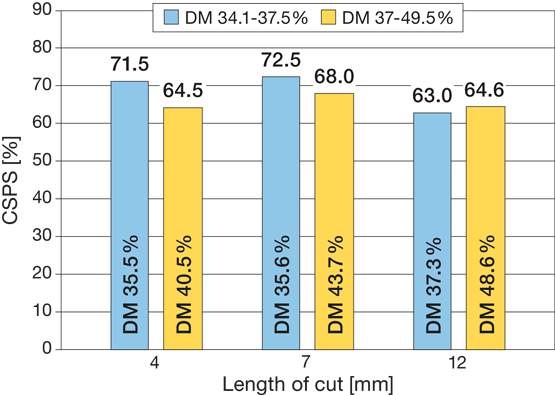
Corn Silage Processing Score (CSPS)
The efficacy of kernel processing was assessed at the lab by scoring the samples according to the CSPS index (Figure 11).
According to Mertens (2005) and LUFA NRW, kernel processing was very good when the chop length was set to 4 mm and 7 mm. At these chop lengths, the score is significantly higher and slightly higher than 70 % respectively.
With a chop length of 12 mm, as well as in all tests conducted in the higher dry matter content level, the John Deere 9500 i achieved good grain preparation levels.
Summary
In the DLG test, the John Deere 9500 i forage harvester (model year 2023) in the tested specification achieved a throughput of 270 tonnes of fresh matter per hour at a theoretical chop length of 12 mm and 225 tonnes of fresh mass per hour at a theoretical chop length of 4 mm. At the same time, specific fuel consumption in litres per tonne of harvested fresh mass was at a low level across all setting variants, with values between 0.49 l/t (12 mm) and 0.58 l/t (4 mm).
The test shows clearly that preselecting a different length of cut on the forager has a clear effect on the chop length distribution in the harvested material. The chop length proportions shift accordingly. Regardless of the moisture contents of the material, overlengths (> 33 mm and > 19 mm) accounted for only a small portion. Comparatively high weight fractions of fine particles (< 3 mm) are found in both dry matter content levels. According to the recommendations of the German Society for Nutritional Physiology (GfE), the desired upper limit of 3 % by weight for the determined portions of ultra-fine particles (< 1.18 mm) is not exceeded in the lower dry matter content level and is slightly exceeded in the higher dry matter content level. This is due to the degree of maturity of the crop (DM content up to 49.5 %).
According to MERTENS (2005) and LUFA NRW, kernel processing was very good, producing 4 mm and 7 mm chop lengths with CSPS values of over and near 70 % respectively. With a chop length of 12 mm, as well as in all tests conducted in the higher dry matter content level, the John Deere 9500 i achieved good grain preparation levels.
Based on these test results, the self-propelled John Deere 9500 i forage harvester is awarded the “DLG APPROVED” quality mark for the individual test criterion “Functionality and quality of work in silage maize”.
Contact
DLG TestService GmbH - Groß-Umstadt location • Max-Eyth-Weg 1 64823 Groß-Umstadt Germany • Tel.: +49(0)69 24 788-611 • tech@DLG.org

